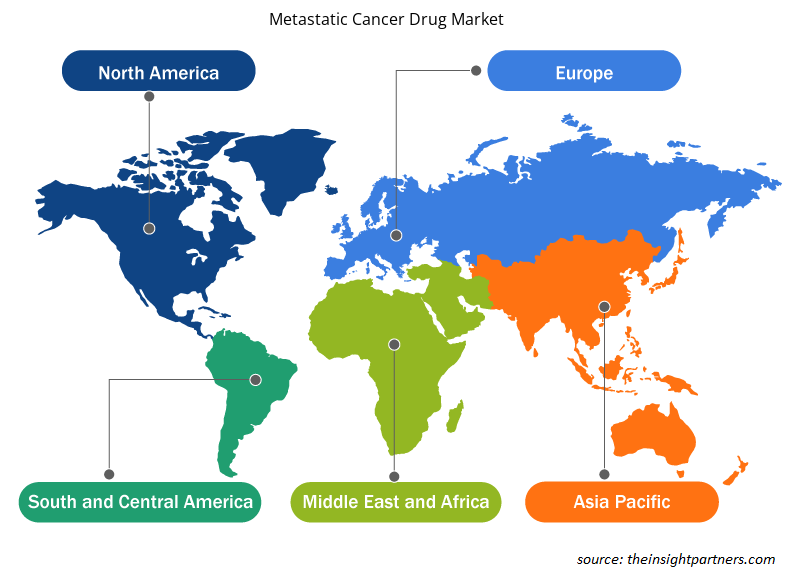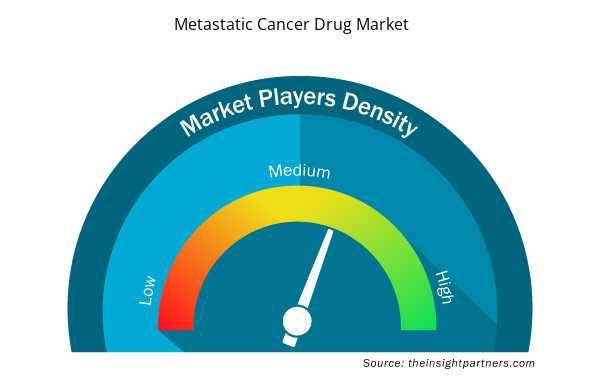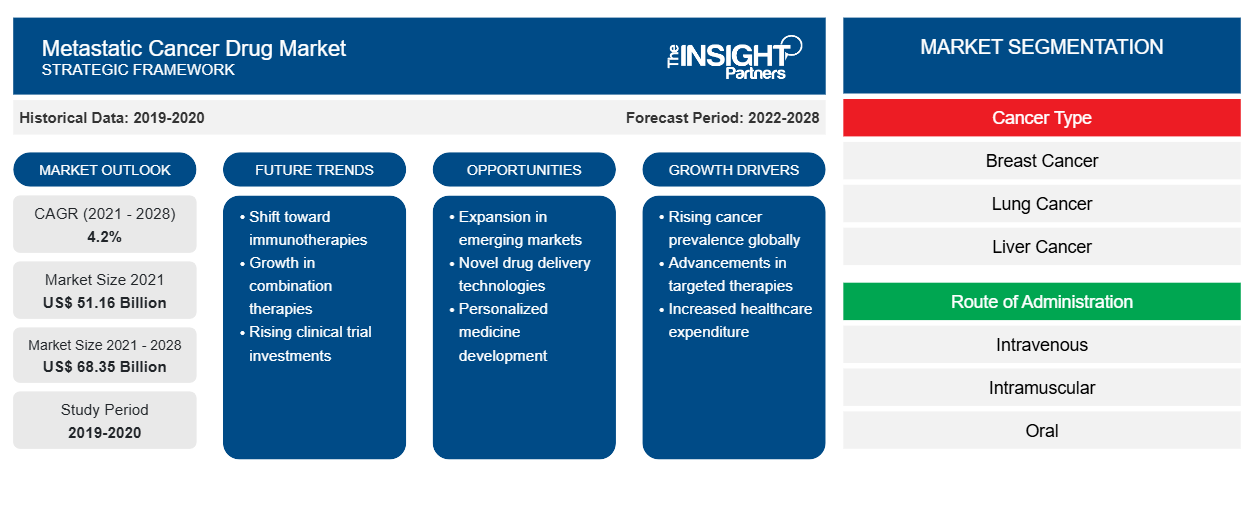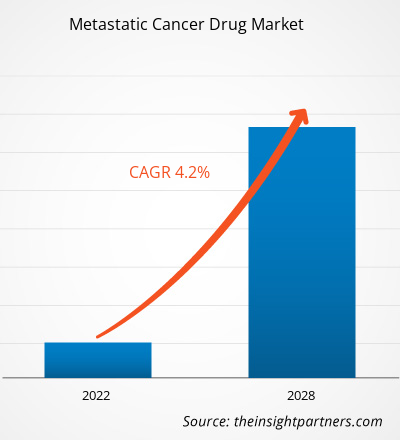[Rapporto di ricerca] Si prevede che il mercato dei farmaci contro il cancro metastatico raggiungerà i 68.349,54 milioni di dollari entro il 2028, rispetto ai 51.157,97 milioni di dollari del 2021. Si prevede che crescerà a un CAGR del 4,2% dal 2021 al 2028.CAGR of 4.2% from 2021 to 2028.
Il cancro metastatico è definito come un cancro in fase avanzata che si diffonde ad altre parti del corpo, e i farmaci usati per il trattamento del cancro in fase avanzata sono noti come farmaci per il cancro metastatico. Questi farmaci sono usati tramite varie terapie, come chemioterapia, immunoterapia e terapia mirata.
Il mercato dei farmaci per il cancro metastatico viene analizzato in base al tipo di cancro, alla via di somministrazione, alla classe di farmaci, al prodotto, all'utente finale e alla geografia. Il mercato, per geografia, è ampiamente segmentato in Nord America, Europa, Asia Pacifico, Medio Oriente e Africa e Sud e Centro America. Il rapporto offre approfondimenti e analisi approfondite del mercato, sottolineando i parametri, come le dimensioni del mercato dei farmaci per il cancro metastatico, le tendenze, i progressi tecnologici e le dinamiche di mercato, insieme all'analisi del panorama competitivo dei principali attori del mercato a livello mondiale.
Personalizza questo report in base alle tue esigenze
Riceverai la personalizzazione gratuita di qualsiasi report, comprese parti di questo report, o analisi a livello nazionale, pacchetto dati Excel, oltre a usufruire di grandi offerte e sconti per start-up e università
- Scopri le principali tendenze di mercato in questo rapporto.Questo campione GRATUITO includerà analisi di dati che spaziano dalle tendenze di mercato alle stime e alle previsioni.
Il mercato dei farmaci per il cancro metastatico è attribuito all'elevata prevalenza del cancro metastatico e alle iniziative governative per supportare gli sviluppi nel trattamento del cancro. Tuttavia, l'elevato costo dei farmaci oncologici limita la crescita del mercato dei farmaci per il cancro metastatico.
Market Insights
Alta prevalenza di cancro metastatico
Il cancro è una delle condizioni di salute che ha un impatto significativo sulle società in tutto il mondo. Secondo i dati forniti dal National Institute of Cancer, nel 2020, 1.806.590 persone soffrivano di cancro negli Stati Uniti, mentre 606.520 persone sono morte di cancro. Secondo l'American Institute of Cancer Research, nel 2020, 18.100 casi erano attivi in tutto il mondo. Inoltre, l'Organizzazione mondiale della sanità (OMS) ha affermato che 10.000 decessi, ovvero 1 su 6 decessi a livello globale, erano dovuti al cancro. I tipi di cancro più comuni sono il cancro ai polmoni, il cancro al seno, il cancro al colon, il cancro al retto e il cancro alla prostata. La condizione si sviluppa in 400.000 bambini ogni anno. Le infezioni cancerogene, tra cui Helicobacter pylori, virus dell'epatite B, papillomavirus umano (HPV), virus dell'epatite C e virus di Epstein-Barr, hanno causato il 13% dei casi di cancro nel 2018, a livello globale. L'Agenzia Internazionale per la Ricerca sul Cancro (IARC) prevede che il numero di nuovi casi di cancro e di decessi correlati al cancro in tutto il mondo crescerà di 1,6-1,7 volte entro il 2040, raggiungendo i 29,5 milioni e passando dai 16,4 milioni del 2018. Inoltre, secondo l'American Society of Clinical Oncology, nel 2021, 290.560 persone (287.850 donne e 2.710 uomini) negli Stati Uniti hanno ricevuto una diagnosi di cancro al seno invasivo. Il cancro al seno nelle donne ha ormai superato il cancro ai polmoni ed è riconosciuto come il tipo di cancro più comune al mondo. Circa 2.261.419 donne hanno ricevuto una diagnosi di cancro al seno nel 2020.papillomavirus (HPV), hepatitis C virus, and Epstein-Barr virus—caused 13% of cancer cases in 2018, globally. The International Agency for Research on Cancer (IARC) projects that the number of new cancer cases and cancer-related deaths worldwide will grow 1.6–1.7 fold by 2040 to reach 29.5 million and from 16.4 million in 2018. Further, according to the American Society of Clinical Oncology, in 2021, 290,560 people (287,850 women and 2,710 men) in the US were diagnosed with invasive breast cancer. Breast cancer in females has now surpassed lung cancer and is recognized as the most common cancer type worldwide. Approximately, 2,261,419 women were diagnosed with breast cancer in 2020.
Tra tutte le osservazioni registrate sul cancro negli Stati Uniti negli ultimi decenni, una statistica è rimasta invariata: il cancro metastatico rappresenta fino al 90% di tutti i decessi per cancro ogni anno. Questi numeri hanno motivato medici e ricercatori a trovare nuovi modi per trattare la metastasi, che si verifica quando il cancro si diffonde oltre il suo punto di origine. Negli Stati Uniti, il 6% delle donne ha ricevuto una diagnosi di cancro al seno metastatico alla prima diagnosi. Un tale aumento della prevalenza del cancro metastatico sta guidando la crescita del mercato dei farmaci contro il cancro metastatico.
In Nord America, si prevede che il Canada assisterà a una crescita considerevole nel periodo di previsione. I principali farmaci immunoterapici utilizzati in Canada sono ipilimumab (Yervoy), pembrolizumab (Keytruda), nivolumab (Opdivo), durvalumab (Imfinzi) e atezolizumab (Tecentriq). Tuttavia, ci sono altri inibitori dei checkpoint pronti a portare la crescita complessiva del mercato.immunotherapy drugs used in Canada are ipilimumab (Yervoy), pembrolizumab (Keytruda), nivolumab (Opdivo), durvalumab (Imfinzi) and atezolizumab (Tecentriq). However, there are other checkpoint inhibitors poised to bring the overall market growth.
Approfondimenti basati sul tipo di cancro
In base al tipo di cancro, il mercato dei farmaci per il cancro metastatico è segmentato in cancro al seno, cancro ai polmoni, cancro al fegato , cancro ematologico , cancro al cervello, cancro alla prostata, cancro al pancreas e altri. Il segmento del cancro al seno ha rappresentato la quota di mercato più grande nel 2021 e si prevede che registrerà il CAGR più elevato durante il periodo di previsione.CAGR during the forecast period.
Approfondimenti basati sulla via di somministrazione
In base alla via di somministrazione, il mercato dei farmaci per il cancro metastatico è segmentato in endovenoso, intramuscolare, orale e altri. Il segmento endovenoso ha rappresentato la quota di mercato maggiore nel 2021 e si prevede che registrerà il CAGR più elevato durante il periodo di previsione.
Approfondimenti basati sulla classe di farmaci
In base alla classe di farmaci, il mercato dei farmaci per il cancro metastatico è suddiviso in inibitori HER2, inibitori dei checkpoint immunitari , inibitori PARP, inibitori delle chinasi e altri. Il segmento degli inibitori PARP ha rappresentato la quota di mercato maggiore nel 2021. Tuttavia, si prevede che il segmento degli inibitori HER2 registrerà il CAGR più elevato durante il periodo di previsione.
Approfondimenti regionali sul mercato dei farmaci per il cancro metastatico
Le tendenze regionali e i fattori che influenzano il mercato dei farmaci per il cancro metastatico durante il periodo di previsione sono stati ampiamente spiegati dagli analisti di Insight Partners. Questa sezione discute anche i segmenti e la geografia del mercato dei farmaci per il cancro metastatico in Nord America, Europa, Asia Pacifico, Medio Oriente e Africa e America meridionale e centrale.

- Ottieni i dati specifici regionali per il mercato dei farmaci contro il cancro metastatico
Ambito del rapporto sul mercato dei farmaci per il cancro metastatico
| Attributo del report | Dettagli |
|---|---|
| Dimensioni del mercato nel 2021 | 51,16 miliardi di dollari USA |
| Dimensioni del mercato entro il 2028 | 68,35 miliardi di dollari USA |
| CAGR globale (2021 - 2028) | 4,2% |
| Dati storici | 2019-2020 |
| Periodo di previsione | 2022-2028 |
| Segmenti coperti | Per tipo di cancro
|
| Regioni e Paesi coperti | America del Nord
|
| Leader di mercato e profili aziendali chiave |
|
Densità degli attori del mercato dei farmaci per il cancro metastatico: comprendere il suo impatto sulle dinamiche aziendali
Il mercato dei farmaci per il cancro metastatico sta crescendo rapidamente, spinto dalla crescente domanda degli utenti finali dovuta a fattori quali l'evoluzione delle preferenze dei consumatori, i progressi tecnologici e una maggiore consapevolezza dei benefici del prodotto. Con l'aumento della domanda, le aziende stanno ampliando le loro offerte, innovando per soddisfare le esigenze dei consumatori e capitalizzando sulle tendenze emergenti, il che alimenta ulteriormente la crescita del mercato.
La densità degli operatori di mercato si riferisce alla distribuzione di aziende o società che operano in un particolare mercato o settore. Indica quanti concorrenti (operatori di mercato) sono presenti in un dato spazio di mercato in relazione alle sue dimensioni o al valore di mercato totale.
Le principali aziende che operano nel mercato dei farmaci per il cancro metastatico sono:
- AbbVie Inc.
- Società anonima Amgen Inc.
- Società Bristol-Myers Squibb
- F. HOFFMANN-LA ROCHE LTD.
- Novartis AG
Disclaimer : le aziende elencate sopra non sono classificate secondo un ordine particolare.

- Ottieni una panoramica dei principali attori del mercato dei farmaci per il cancro metastatico
Approfondimenti basati sui prodotti
In base al prodotto, il mercato dei farmaci per il cancro metastatico è diviso in branded e generici e biosimilari. Il segmento branded ha rappresentato una quota di mercato maggiore nel 2021. Tuttavia, si stima che il segmento generici e biosimilari registrerà un CAGR più elevato durante il periodo di previsione.
Informazioni basate sull'utente finale
In base all'utente finale, il mercato dei farmaci per il cancro metastatico è segmentato in ospedali, cliniche specialistiche e altri. Il segmento ospedaliero ha rappresentato la quota maggiore nel 2021, mentre si stima che il segmento delle cliniche specialistiche registrerà il CAGR più elevato durante il periodo di previsione.
I lanci e le approvazioni di prodotti sono tra le strategie comunemente adottate dalle aziende per espandere la propria presenza globale e i portafogli di prodotti. Gli operatori del mercato dei farmaci per il cancro metastatico si concentrano anche sulla strategia di partnership per ampliare la propria clientela, il che, a sua volta, consente loro di mantenere il proprio marchio in tutto il mondo. Mirano a far crescere le proprie quote di mercato con lo sviluppo di prodotti innovativi.
AbbVie Inc.; Amgen Inc.; Bristol-Myers Squibb Company; F. HOFFMANN-LA ROCHE LTD.; Novartis AG; ASTRAZENECA PLC.; Eli Lilly and Company; MERCK KGaA; e Pfizer Inc. (Arena Pharmaceutical GmbH); e Johnson and Johnson Services, Inc. sono le aziende leader che operano nel mercato dei farmaci contro il cancro metastatico.
- Analisi storica (2 anni), anno base, previsione (7 anni) con CAGR
- Analisi PEST e SWOT
- Valore/volume delle dimensioni del mercato - Globale, regionale, nazionale
- Industria e panorama competitivo
- Set di dati Excel



Report Coverage
Revenue forecast, Company Analysis, Industry landscape, Growth factors, and Trends

Segment Covered
This text is related
to segments covered.

Regional Scope
North America, Europe, Asia Pacific, Middle East & Africa, South & Central America

Country Scope
This text is related
to country scope.
Domande frequenti
Cancer that spreads from where it started to a distant part of the body is called metastatic cancer. The process by which cancer cells spread to other parts of the body is called metastasis. Metastatic cancer is an advanced cancer stage that spread to the other body parts and the drugs used for the treatment of advanced stage cancer are known as metastatic cancer drugs. These drugs are used through various therapies such as chemotherapy, immunotherapy, and targeted therapy.
The factors that are driving and restraining factors that will affect the metastatic cancer drugs market in the coming years. The growth of the market is attributed to some key driving factors such as increasing prevalence of cancer and government initiatives to support drug developments for cancer treatment. However, high cost of oncology drugs is likely to hinder the market growth.
The metastatic cancer drug market, by cancer type, is bifurcated into breast cancer, lung cancer, liver cancer, hematological cancer, brain cancer, prostate cancer, pancreatic cancer, and others. The breast cancer segment held the largest share in 2021 and is anticipated to register the highest CAGR during the forecast period.
The metastatic cancer drug market majorly consists of the players such as AbbVie Inc., Amgen Inc., Bristol-Myers Squibb Company, F. HOFFMANN-LA ROCHE LTD., Novartis AG, ASTRAZENECA PLC., Eli Lilly and Company, MERCK KGaA, and Pfizer Inc. (Arena Pharmaceutical GmbH) amongst others.
Trends and growth analysis reports related to Life Sciences : READ MORE..
The List of Companies - Metastatic Cancer Drug Market
- AbbVie Inc.
- Amgen Inc.
- Bristol-Myers Squibb Company
- F. HOFFMANN-LA ROCHE LTD.
- Novartis AG
- ASTRAZENECA PLC.
- Eli Lilly and Company
- MERCK KGaA
- Pfizer Inc. (Arena Pharmaceutical GmbH)
The Insight Partners performs research in 4 major stages: Data Collection & Secondary Research, Primary Research, Data Analysis and Data Triangulation & Final Review.
- Data Collection and Secondary Research:
As a market research and consulting firm operating from a decade, we have published and advised several client across the globe. First step for any study will start with an assessment of currently available data and insights from existing reports. Further, historical and current market information is collected from Investor Presentations, Annual Reports, SEC Filings, etc., and other information related to company’s performance and market positioning are gathered from Paid Databases (Factiva, Hoovers, and Reuters) and various other publications available in public domain.
Several associations trade associates, technical forums, institutes, societies and organization are accessed to gain technical as well as market related insights through their publications such as research papers, blogs and press releases related to the studies are referred to get cues about the market. Further, white papers, journals, magazines, and other news articles published in last 3 years are scrutinized and analyzed to understand the current market trends.
- Primary Research:
The primarily interview analysis comprise of data obtained from industry participants interview and answers to survey questions gathered by in-house primary team.
For primary research, interviews are conducted with industry experts/CEOs/Marketing Managers/VPs/Subject Matter Experts from both demand and supply side to get a 360-degree view of the market. The primary team conducts several interviews based on the complexity of the markets to understand the various market trends and dynamics which makes research more credible and precise.
A typical research interview fulfils the following functions:
- Provides first-hand information on the market size, market trends, growth trends, competitive landscape, and outlook
- Validates and strengthens in-house secondary research findings
- Develops the analysis team’s expertise and market understanding
Primary research involves email interactions and telephone interviews for each market, category, segment, and sub-segment across geographies. The participants who typically take part in such a process include, but are not limited to:
- Industry participants: VPs, business development managers, market intelligence managers and national sales managers
- Outside experts: Valuation experts, research analysts and key opinion leaders specializing in the electronics and semiconductor industry.
Below is the breakup of our primary respondents by company, designation, and region:

Once we receive the confirmation from primary research sources or primary respondents, we finalize the base year market estimation and forecast the data as per the macroeconomic and microeconomic factors assessed during data collection.
- Data Analysis:
Once data is validated through both secondary as well as primary respondents, we finalize the market estimations by hypothesis formulation and factor analysis at regional and country level.
- Macro-Economic Factor Analysis:
We analyse macroeconomic indicators such the gross domestic product (GDP), increase in the demand for goods and services across industries, technological advancement, regional economic growth, governmental policies, the influence of COVID-19, PEST analysis, and other aspects. This analysis aids in setting benchmarks for various nations/regions and approximating market splits. Additionally, the general trend of the aforementioned components aid in determining the market's development possibilities.
- Country Level Data:
Various factors that are especially aligned to the country are taken into account to determine the market size for a certain area and country, including the presence of vendors, such as headquarters and offices, the country's GDP, demand patterns, and industry growth. To comprehend the market dynamics for the nation, a number of growth variables, inhibitors, application areas, and current market trends are researched. The aforementioned elements aid in determining the country's overall market's growth potential.
- Company Profile:
The “Table of Contents” is formulated by listing and analyzing more than 25 - 30 companies operating in the market ecosystem across geographies. However, we profile only 10 companies as a standard practice in our syndicate reports. These 10 companies comprise leading, emerging, and regional players. Nonetheless, our analysis is not restricted to the 10 listed companies, we also analyze other companies present in the market to develop a holistic view and understand the prevailing trends. The “Company Profiles” section in the report covers key facts, business description, products & services, financial information, SWOT analysis, and key developments. The financial information presented is extracted from the annual reports and official documents of the publicly listed companies. Upon collecting the information for the sections of respective companies, we verify them via various primary sources and then compile the data in respective company profiles. The company level information helps us in deriving the base number as well as in forecasting the market size.
- Developing Base Number:
Aggregation of sales statistics (2020-2022) and macro-economic factor, and other secondary and primary research insights are utilized to arrive at base number and related market shares for 2022. The data gaps are identified in this step and relevant market data is analyzed, collected from paid primary interviews or databases. On finalizing the base year market size, forecasts are developed on the basis of macro-economic, industry and market growth factors and company level analysis.
- Data Triangulation and Final Review:
The market findings and base year market size calculations are validated from supply as well as demand side. Demand side validations are based on macro-economic factor analysis and benchmarks for respective regions and countries. In case of supply side validations, revenues of major companies are estimated (in case not available) based on industry benchmark, approximate number of employees, product portfolio, and primary interviews revenues are gathered. Further revenue from target product/service segment is assessed to avoid overshooting of market statistics. In case of heavy deviations between supply and demand side values, all thes steps are repeated to achieve synchronization.
We follow an iterative model, wherein we share our research findings with Subject Matter Experts (SME’s) and Key Opinion Leaders (KOLs) until consensus view of the market is not formulated – this model negates any drastic deviation in the opinions of experts. Only validated and universally acceptable research findings are quoted in our reports.
We have important check points that we use to validate our research findings – which we call – data triangulation, where we validate the information, we generate from secondary sources with primary interviews and then we re-validate with our internal data bases and Subject matter experts. This comprehensive model enables us to deliver high quality, reliable data in shortest possible time.


 Ottieni un campione gratuito per questo repot
Ottieni un campione gratuito per questo repot